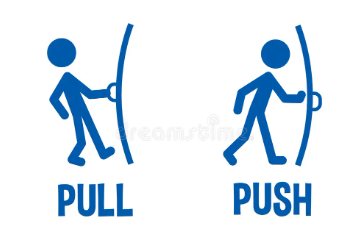
Recently, a former colleague asked me what I thought about push versus pull learning. I knew the terms more from social media marketing but hadn't really used them in learning situations. In marketing, examples include whether to decide to subscribe to a newsletter by email or snail mail (you pull that information by choice) or a newsletter that comes to you automatically (it is pushed at you).
In general, I think people prefer to pull (choice) over having it pushed at them. Companies might prefer to push, but that probably comes with the option to stop that push (unsubscribe.)
Moving these approaches - or just the terms - to education makes some sense.
In a push approach, teachers decide on the information, approach, delivery method, and speed of delivery. It is how education has been done for centuries. It tends to start with what Bloom and his taxonomy would categorize as knowledge-level remember and understand questions. These would build toward more critical and creative thinking. With pull, students enter into creating, evaluating and analyzing that requires them to seek knowledge and understanding.
This conventional classroom-styled learning is not the only approach in the 21st century. Pull learning allows learners to access information at the point of need, the way they prefer (in some settings) at the speed they find comfortable. I think that the initial surge of MOOCs back in 2012 is a good example of learning that learners pulled as needed.
Pull puts learners more in control It flips the teacher-centered learning setting. However, we must acknowledge that learning in school at all levels is still very much push learning. Fortunately, the idea that students should be able to pull some learning as they feel they need it is gaining more acceptance and is being incorporated in instructional design planning.
Currently, pull learning experiences are probably best suited to workers who have learning needs based on job roles, personal knowledge, and advancing their career interests.
Ideally, learning is "push-pull" with appropriate information provided by a push and additional information required to complete tasks and goals pulled as needed. This is not really a new approach. When you were a student, you were certainly pushed information, but you might well have gone beyond what was provided and pulled additional information that you felt you needed.
MORE
https://www.responsiveinboundmarketing.com/blog/the-difference-between-push-and-pull-learning
https://www.teachthought.com/education/push-teaching-vs-pull-teaching-thinking/
https://barkleypd.com/blog/pushing-or-pulling/
 Coursera’s CEO, Jeff Maggioncalda, says leveraging AI in online learning is key to a more accessible, flexible education experience. Coursera is a major platform for free and paid, non-credit and credit learning opportunities. Remember MOOCs? The term isn't in as wide usage as it was a decade ago but Coursera was an early serious player in that space and still offers short-form training and master’s degrees from Ivy League institutions like the University of Pennsylvania.
Coursera’s CEO, Jeff Maggioncalda, says leveraging AI in online learning is key to a more accessible, flexible education experience. Coursera is a major platform for free and paid, non-credit and credit learning opportunities. Remember MOOCs? The term isn't in as wide usage as it was a decade ago but Coursera was an early serious player in that space and still offers short-form training and master’s degrees from Ivy League institutions like the University of Pennsylvania. When I was teaching in a high school, I used to tell students (and faculty) that we were not preparing them for jobs. I was sure many of our students would end up in jobs with titles that did not exist then. There is a song by The Byrds from the 1960s titled "So You Wanna Be a Rock 'n' Roll Star." In 2024, it could be "So You Want To Be An AI Prompt Engineer."
When I was teaching in a high school, I used to tell students (and faculty) that we were not preparing them for jobs. I was sure many of our students would end up in jobs with titles that did not exist then. There is a song by The Byrds from the 1960s titled "So You Wanna Be a Rock 'n' Roll Star." In 2024, it could be "So You Want To Be An AI Prompt Engineer."
